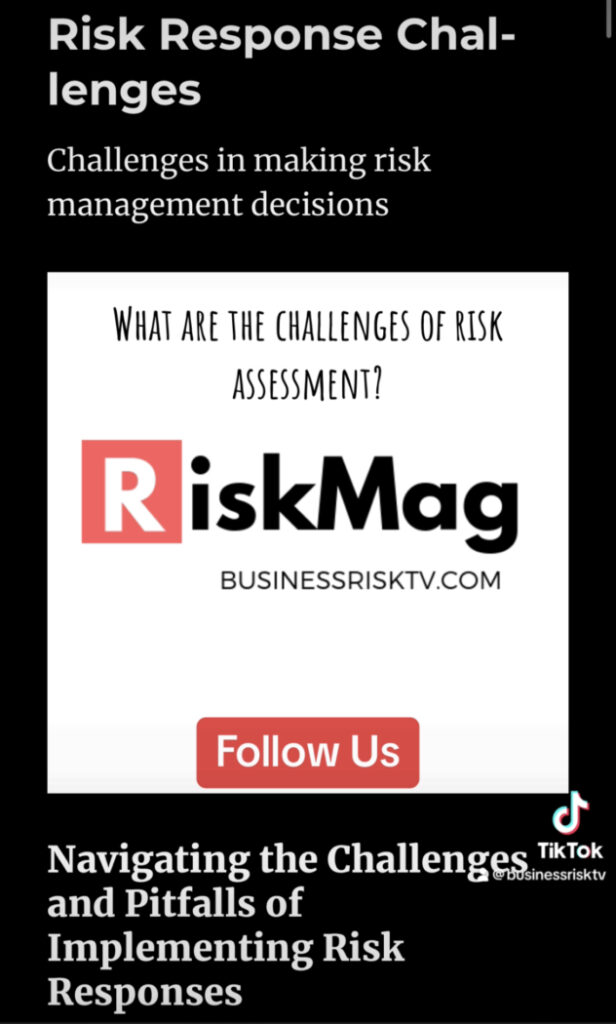Navigating the Challenges and Pitfalls of Implementing Risk Responses
In today’s fast-paced and uncertain business landscape, organisations must proactively manage risks to safeguard their operations and enhance their chances of success. Implementing risk responses is a crucial aspect of risk management, as it allows businesses to address potential threats and seize opportunities effectively. However, this process is not without its challenges and pitfalls. In this article, we will explore some of the common obstacles faced by organizations when implementing risk responses and discuss strategies to overcome them.
- Inadequate Risk Identification and Assessment
One of the fundamental challenges in implementing risk responses lies in identifying and assessing risks accurately. Without a comprehensive understanding of potential risks, organisations may struggle to develop appropriate responses. This challenge often arises due to insufficient data, poor risk assessment methodologies, or a lack of expertise.
To mitigate this challenge, organisations should invest in robust risk identification processes, leveraging techniques such as brainstorming sessions, expert interviews, and data analysis. By involving stakeholders from various levels and departments, businesses can enhance their ability to identify and evaluate risks effectively. Additionally, regular reviews and updates of risk assessments ensure that new risks are captured and addressed promptly.
- Ambiguous Risk Ownership and Accountability
Assigning clear ownership and accountability for risk responses is essential for their successful implementation. However, organisations often face challenges in determining who should be responsible for specific risks. This ambiguity can result in delayed or ineffective responses, as nobody takes ownership of the risk mitigation process.
To address this challenge, it is crucial to establish a well-defined governance structure that outlines roles and responsibilities for risk management. This structure should clearly designate risk owners and empower them to make informed decisions regarding risk responses. Regular communication and collaboration between risk owners and other stakeholders will facilitate the smooth execution of risk responses and ensure accountability.
- Insufficient Resources and Budget
Implementing risk responses requires adequate resources, including financial, human, and technological support. However, organisations often face the challenge of limited resources and budget constraints. Insufficient resources can hinder the implementation of risk responses and compromise an organisation’s ability to address risks effectively.
To overcome this challenge, organisations should prioritise risk management as a strategic imperative and allocate sufficient resources accordingly. Senior management must understand the importance of investing in risk responses and advocate for the necessary budget. Additionally, leveraging technology solutions, automation, and outsourcing can optimize resource allocation and enhance the efficiency of risk response implementation.
- Resistance to Change and Lack of Buy-In
Implementing risk responses often requires changes in processes, policies, and organisational culture. However, organisations frequently encounter resistance to change from employees who may be comfortable with the status quo. Without buy-in from key stakeholders, implementing risk responses becomes an uphill battle.
To address resistance to change, organisations must develop a comprehensive change management plan that includes effective communication, training, and engagement strategies. By involving employees early in the process, fostering a culture of risk awareness and accountability, and providing clear rationale for the proposed changes, organisations can increase buy-in and minimize resistance.
- Ineffective Monitoring and Review
Successful implementation of risk responses requires ongoing monitoring and review to ensure their effectiveness. However, organisations often face challenges in establishing robust monitoring mechanisms and conducting timely reviews.
To overcome this challenge, organisations should develop key performance indicators (KPIs) and establish regular monitoring processes to track the progress of risk responses. These KPIs should align with the organisation’s objectives and allow for effective measurement of risk mitigation efforts. Regular reviews and evaluations will enable organisations to identify any gaps or shortcomings in their risk response strategies and make necessary adjustments.

Implementing risk responses is a critical aspect of effective risk management, enabling organisations to proactively address threats and seize opportunities. However, navigating the challenges and pitfalls in this process is essential to ensure successful outcomes. By addressing challenges such as inadequate risk identification, ambiguous ownership, resource constraints, resistance to change, and ineffective monitoring, organizations can enhance their ability to implement risk responses effectively. By developing robust strategies to overcome these obstacles, organisations will be better equipped to navigate the ever-evolving business landscape and safeguard their long-term success.
More risk management articles videos and reviews
Risk Response Challenges
